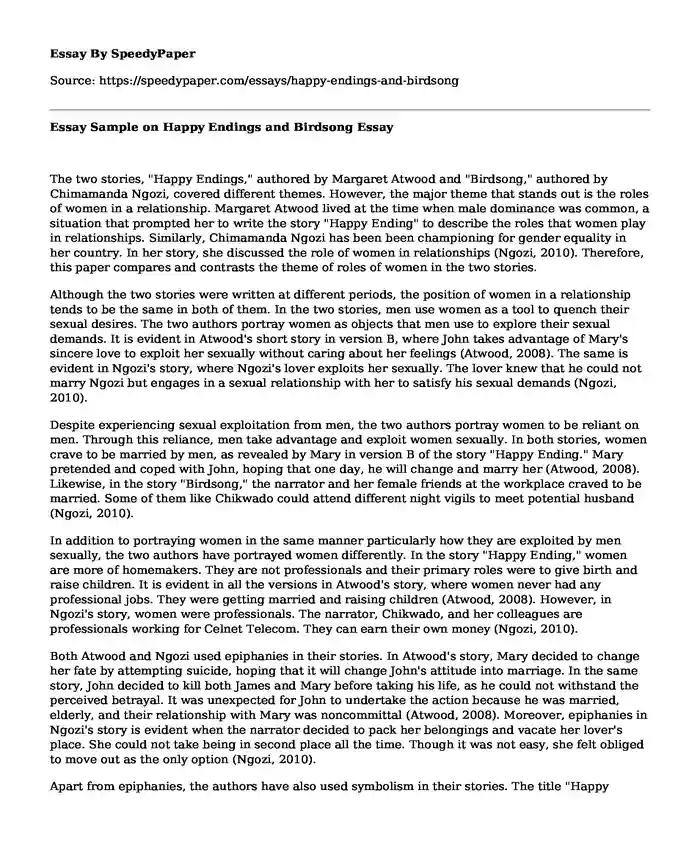
| Type of paper: | Essay |
| Categories: | Women Relationship Sexual abuse Gender in literature |
| Pages: | 3 |
| Wordcount: | 734 words |
The two stories, "Happy Endings," authored by Margaret Atwood and "Birdsong," authored by Chimamanda Ngozi, covered different themes. However, the major theme that stands out is the roles of women in a relationship. Margaret Atwood lived at the time when male dominance was common, a situation that prompted her to write the story "Happy Ending" to describe the roles that women play in relationships. Similarly, Chimamanda Ngozi has been been championing for gender equality in her country. In her story, she discussed the role of women in relationships (Ngozi, 2010). Therefore, this paper compares and contrasts the theme of roles of women in the two stories.
Although the two stories were written at different periods, the position of women in a relationship tends to be the same in both of them. In the two stories, men use women as a tool to quench their sexual desires. The two authors portray women as objects that men use to explore their sexual demands. It is evident in Atwood's short story in version B, where John takes advantage of Mary's sincere love to exploit her sexually without caring about her feelings (Atwood, 2008). The same is evident in Ngozi's story, where Ngozi's lover exploits her sexually. The lover knew that he could not marry Ngozi but engages in a sexual relationship with her to satisfy his sexual demands (Ngozi, 2010).
Despite experiencing sexual exploitation from men, the two authors portray women to be reliant on men. Through this reliance, men take advantage and exploit women sexually. In both stories, women crave to be married by men, as revealed by Mary in version B of the story "Happy Ending." Mary pretended and coped with John, hoping that one day, he will change and marry her (Atwood, 2008). Likewise, in the story "Birdsong," the narrator and her female friends at the workplace craved to be married. Some of them like Chikwado could attend different night vigils to meet potential husband (Ngozi, 2010).
In addition to portraying women in the same manner particularly how they are exploited by men sexually, the two authors have portrayed women differently. In the story "Happy Ending," women are more of homemakers. They are not professionals and their primary roles were to give birth and raise children. It is evident in all the versions in Atwood's story, where women never had any professional jobs. They were getting married and raising children (Atwood, 2008). However, in Ngozi's story, women were professionals. The narrator, Chikwado, and her colleagues are professionals working for Celnet Telecom. They can earn their own money (Ngozi, 2010).
Both Atwood and Ngozi used epiphanies in their stories. In Atwood's story, Mary decided to change her fate by attempting suicide, hoping that it will change John's attitude into marriage. In the same story, John decided to kill both James and Mary before taking his life, as he could not withstand the perceived betrayal. It was unexpected for John to undertake the action because he was married, elderly, and their relationship with Mary was noncommittal (Atwood, 2008). Moreover, epiphanies in Ngozi's story is evident when the narrator decided to pack her belongings and vacate her lover's place. She could not take being in second place all the time. Though it was not easy, she felt obliged to move out as the only option (Ngozi, 2010).
Apart from epiphanies, the authors have also used symbolism in their stories. The title "Happy Ending" in Atwood's story is symbolic in itself. In all the versions, all of them are referred to version A, where John and Mary die. Therefore, in the story, "Happy Ending," symbolizes death where the oppressed find peace and rest (Atwood, 2008). Similarly, in Ngozi's story, the beautiful woman in the jeep that tormented the narrator was symbolic. She symbolizes fear that women who are involved in a romantic relationship with married men have to face. Birds in the story are also symbolic. They symbolize a perfect and pure relationship that should exist in society (Ngozi, 2010).
In conclusion, the two stories by Margaret Atwood and Chimamanda Ngozi describe the roles that women play in relationships. They are also similar in the way they cover literacy devices including epiphanies and symbolism. Despite these similarities, the stories are different in how they cover literacy terms.
References
Atwood, M. (2008). Happy Endings.''1983. Fiction: A Pocket Anthology. 2nd Canadian ed. RS Gwynn and Wanda Campbell, ed. s. Toronto: Penguin Academics/Pearson Longman, 253-56.
Ngozi, C., (2010). Birdsong. USA: New Yorker.
Cite this page
Essay Sample on Happy Endings and Birdsong. (2023, Jan 23). Retrieved from https://speedypaper.net/essays/happy-endings-and-birdsong
Request Removal
If you are the original author of this essay and no longer wish to have it published on the SpeedyPaper website, please click below to request its removal:
- The Scarlet Letter Essay Example
- Ethical-Legal Dilemma in Nursing, Free Paper Sample for You
- Essay Sample Dedicated to Gender Pay Gap in Arizona
- Equity method and Disclosures - Free Essay in Accounting
- Free Essay Comprising an Amadeus Cultural Activity Report
- Dembski's Book: Religion, Science & Intelligent Design. Essay Example
- Free Paper Sample on Objectivity for Biased Journalists
Popular categories




